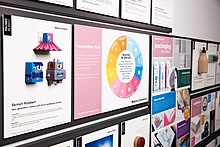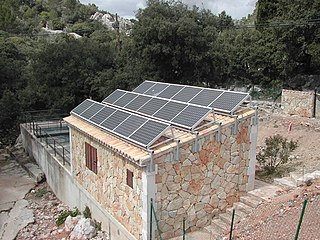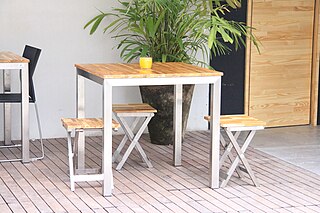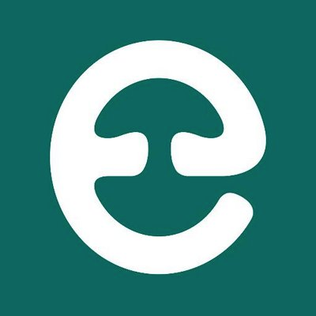

Material ConneXion is a materials consultancy, headquartered in New York City, New York.


Material ConneXion is a materials consultancy, headquartered in New York City, New York.
In 1997, Material ConneXion was launched by George Beylerian, former vice president of marketing and creative director of Steelcase Furniture. [1] At Steelcase, Beylerian created a small exhibition of new materials, and recognized the need for a materials library service. [1]
Material ConneXion was acquired by SANDOW in 2011. [2]
In addition to its New York office, the company has locations in Bangkok, Daegu, Milan, and Skövde, and also maintains an online materials database.
Material ConneXion maintains a physical library of over 10,000 materials and processes categorized based on their chemical composition: Polymers, Naturals, Metals, Glass, Processes, Ceramics, Cement-based, Carbon-based. [1]
In 2016, the American Society of Interior Designers (ASID) opened a Material ConneXion Library at its corporate headquarters in Washington, D.C., in partnership with the American Chemistry Council (ACC). The library features samples of innovative materials and products with an emphasis on health and wellness in the built environment. [3]
Material ConneXion clients have included design and architecture firms, government agencies, [4] and large corporations such as Adidas, [5] Target Corporation, [5] PUMA, [6] and BMW. [7]
In 2001, designer Sandy Chilewich discovered a woven vinyl material in Material ConneXion's library that led to her Chilewich brand of household products and accessories. [1] The company also worked with designer Harry Allen to find a sustainable, low-cost, post-industrial polypropylene packaging material for Aveda’s Ukuru line of cosmetics. [8] In 2004, Material ConneXion helped Nike source a monofilament sleeving normally used to protect PVC pipes from bursting for use in its Air Jordan XIX [ broken anchor ]. [9]
Through its partnership with McDonough Braungart Design Chemistry (MBDC) and the Environmental Protection and Encouragement Agency (EPEA), Material ConneXion is the only Materials Library in the world to feature Cradle to Cradle assessed and certified materials and the only materials consultancy to offer Cradle to Cradle Certification and Cradle to Cradle product development. [10]
In 2007, Material ConneXion was named a “Top Eco-Innovator” by The New York Times for its efforts to make information on sustainable materials and sustainable design practices more readily available to designers and corporations. [11]
Janine M. Benyus is an American natural sciences writer, innovation consultant, and author. After writing books on wildlife and animal behavior, she coined the term Biomimicry to describe intentional problem-solving design inspired by nature. Her book Biomimicry (1997) attracted widespread attention from businesspeople in design, architecture, and engineering as well as from scientists. Benyus argues that by following biomimetic approaches, designers can develop products that will perform better, be less expansive, use less energy, and leave companies less open to legal risk.
Green chemistry, similar to sustainable chemistry or circular chemistry, is an area of chemistry and chemical engineering focused on the design of products and processes that minimize or eliminate the use and generation of hazardous substances. While environmental chemistry focuses on the effects of polluting chemicals on nature, green chemistry focuses on the environmental impact of chemistry, including lowering consumption of nonrenewable resources and technological approaches for preventing pollution.

Environment friendly processes, or environmental-friendly processes, are sustainability and marketing terms referring to goods and services, laws, guidelines and policies that claim reduced, minimal, or no harm upon ecosystems or the environment.
Ray C. Anderson was founder and chairman of Interface Inc., one of the world's largest manufacturers of modular carpet for commercial and residential applications and a leading producer of commercial broadloom and commercial fabrics. He was known in environmental circles for his advanced and progressive stance on industrial ecology and sustainability.
SteelcaseInc. is an international manufacturer of furniture, casegoods, seating, and storage and partitioning systems for offices, hospitals, classrooms, and residential interiors. It is headquartered in Grand Rapids, Michigan, United States.

Michael Braungart is a German chemist who advocates that humans can make a positive instead of a negative environmental impact by redesigning industrial production and therefore that dissipation is not waste. A former Greenpeace activist who once lived in a tree as protest, he is now considered to be a visionary environmental thinker.

Cradle-to-cradle design is a biomimetic approach to the design of products and systems that models human industry on nature's processes, where materials are viewed as nutrients circulating in healthy, safe metabolisms. The term itself is a play on the popular corporate phrase "cradle to grave", implying that the C2C model is sustainable and considerate of life and future generations—from the birth, or "cradle", of one generation to the next generation, versus from birth to death, or "grave", within the same generation.

Metropolis is an internationally recognized design and architecture–concentrated magazine with a strong focus on ethics, innovation and sustainability in the creative sector. The magazine was established in 1981 by Horace Havemeyer III of Bellerophon Publications, Inc alongside his wife Eugenie Cowan Havemeyer and is based in New York City. Metropolis's work towards future focused is based in their motto "design at all scales".
The American Society of Interior Designers (ASID) is a nonprofit organization based in the United States that promotes the profession of interior design. It has chapters throughout the United States and Canada. Throughout all of the associations of ASID within the United States and Canada there are many sections within the American Society of Interior Designers, typically in all different states or areas. Each area typically has a certain number of members who work together on making Interior Design a better place and to help other Interior Designers within the organization. All of these sections are incorporated in typical and beneficial ways to make the organization a better environment for everyone. In ASID, interior designers will all come together and work together as a team. Some of the most important parts of ASID and being involved are the extended History, being a member and what kind of benefits a person shall get as being part of this organization, learning the policies, some issues that can be come across, and what the foundation is all about. To be a member is it good to be qualified as a professional or student interior designer.

Yves Béhar is a Swiss-born American designer, entrepreneur, and educator. He is the founder and principal designer of Fuseproject, an industrial design and brand development firm. Béhar is also the co-founder and Chief Creative Officer of August Smart Lock, a smart lock company acquired by Assa Abloy in 2017; and co-founder of Canopy, a co-working space based in San Francisco.

Ecological design or ecodesign is an approach to designing products and services that gives special consideration to the environmental impacts of a product over its entire lifecycle. Sim Van der Ryn and Stuart Cowan define it as "any form of design that minimizes environmentally destructive impacts by integrating itself with living processes." Ecological design can also be defined as the process of integrating environmental considerations into design and development with the aim of reducing environmental impacts of products through their life cycle.

Sustainable packaging is packaging materials and methods that result in improved sustainability. This involves increased use of life cycle inventory (LCI) and life cycle assessment (LCA) to help guide the use of packaging which reduces the environmental impact and ecological footprint. It includes a look at the whole of the supply chain: from basic function, to marketing, and then through to end of life (LCA) and rebirth. Additionally, an eco-cost to value ratio can be useful The goals are to improve the long term viability and quality of life for humans and the longevity of natural ecosystems. Sustainable packaging must meet the functional and economic needs of the present without compromising the ability of future generations to meet their own needs. Sustainability is not necessarily an end state but is a continuing process of improvement.

Tom Hardy is an American design strategist, former head of the Corporate IBM Design Program and Professor of Design Management at Savannah College of Art and Design (SCAD). As corporate design advisor to Samsung Electronics (1996-2003) Hardy was instrumental in transforming their brand image from follower to innovation leader by creating a new brand-design ethos: "Balance of Reason & Feeling", and building significant global brand equity through judicious use of design strategy and management. While at IBM (1970-1992), he was an award-winning industrial designer and later served as corporate head of the IBM Design Program responsible for worldwide brand-design identity. His leadership contributed to the revitalization of IBM's brand image via differentiated design such as the iconic ThinkPad.
Illuminati II is a cotton company producing products from organic and fair trade cotton grown in Uganda. The company is owned by the holding company Noir Illuminati II Holding and was established by Danish fashion designer Peter Ingwersen in 2005 with the aim of ensuring socially sustainable practices by controlling aspects of the supply chain. The company's two fashion lines, Noir and Bllack Noir distribute the company's products.
The Biomimicry Institute is a 501(c)(3) not-for-profit organization founded in 2006 and based in Missoula, Montana in the United States. Its goal is to help innovators learn from nature in order to design sustainable products, processes, and policies in response to real-world problems. The Biomimicry Institute has become a key communicator in the field of biomimetics, connecting thousands of practitioners and organizations across the world. Its Global Network currently supports 38 regional networks across 26 countries as of 2022. The Biomimicry Institute was founded by Bryony Schwan, Dayna Baumeister and Janine Benyus and originated following the publishing of Biomimicry: Innovation Inspired by Nature by Janine Benyus; a natural sciences writer, innovation consultant and author.
Environmentally sustainable design is the philosophy of designing physical objects, the built environment, and services to comply with the principles of ecological sustainability and also aimed at improving the health and comfort of occupants in a building. Sustainable design seeks to reduce negative impacts on the environment, the health and well-being of building occupants, thereby improving building performance. The basic objectives of sustainability are to reduce the consumption of non-renewable resources, minimize waste, and create healthy, productive environments.

Shashi Caan a design futurist, educator and author, her dedication to furthering human betterment through and by design is reflected in her 25-year design career.

Ecovative Design LLC is a materials company headquartered in Green Island, New York, that provides sustainable alternatives to plastics and polystyrene foams for packaging, building materials and other applications by using mushroom technology.
Adam I. Sandow is an American businessman and entrepreneur. He is the founder and chairman of a self-named holding company, and the founder, chairman and CEO of Material Bank, an online platform for searching and sampling architectural, design and construction materials.
Ecopreneurship is a term coined to represent the process of principles of entrepreneurship being applied to create businesses that solve environmental problems or operate sustainably. The term began to be widely used in the 1990s, and it is otherwise referred to as "environmental entrepreneurship." In the book Merging Economic and Environmental Concerns Through Ecopreneurship, written by Gwyn Schuyler in 1998, ecopreneurs are defined as follows:
"Ecopreneurs are entrepreneurs whose business efforts are not only driven by profit, but also by a concern for the environment. Ecopreneurship, also known as environmental entrepreneurship and eco-capitalism, is becoming more widespread as a new market-based approach to identifying opportunities for improving environmental quality and capitalizing upon them in the private sector for profit. "